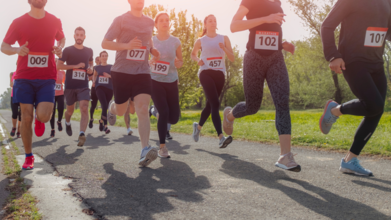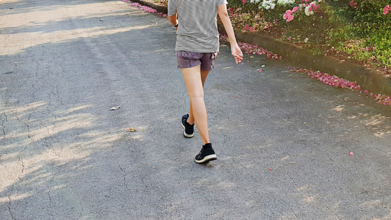- Health Conditions A-Z
- Health & Wellness
- Nutrition
- Fitness
- Health News
- Ayurveda
- Videos
- Medicine A-Z
- Parenting
- Web Stories
Marathon Runners Could Face Shockingly High Risk Of Colon Cancer, Study Finds

Credits: Canva
Marathon runners have been held up as models of peak fitness. With their lean builds, strong hearts, and seemingly endless endurance, they embody the idea that extreme physical activity equals extreme health. But new research is challenging that perception. A recent study led by oncologists at the Inova Schar Cancer Institute in Virginia has revealed a surprising trend: marathon and ultramarathon runners may face a higher risk of developing colon cancer than the general population.
This finding is not only counterintuitive but also potentially life-saving, raising important questions about how extreme exercise affects the body in ways that go beyond muscle strength and cardiovascular fitness.
Dr. Timothy Cannon, an oncologist at Inova Schar, first noticed the potential link in his own clinic. He treated three patients, all under the age of 40, who were accomplished endurance athletes. These men and women didn’t smoke, didn’t drink, and had no family history of colon cancer. One was vegan. Yet each of them had advanced colon cancer. Despite aggressive treatment, all three later passed away.
“It didn’t make sense,” Cannon explained when he presented his findings at the American Society of Clinical Oncology (ASCO) conference. “They were the kind of people we’d expect to be the least likely to develop colon cancer.”
That anomaly drove Cannon and his team to explore whether there was a hidden link between extreme endurance running and colorectal cancer risk.
The research focused on 100 athletes aged 35 to 50 who had completed either at least two ultramarathons (50 km or longer) or five marathons. None had family histories of colorectal cancer or traditional risk factors such as smoking, obesity, or heavy alcohol consumption. When the participants underwent colonoscopies, the results were striking:
- 39% had at least one polyp
- 15% had advanced adenomas, a type of pre-cancerous polyp
By comparison, only about 1.2% of people in their 40s in the general population are expected to have advanced adenomas. The difference was significant and unexpected.
“These were athletes who, on paper, should have been the least likely to show these warning signs,” Cannon said.
Why Would Marathon Running Increase Risk of Colon Cancer?
The study stopped short of proving causation, but experts have floated several theories.
One explanation is that intense endurance exercise diverts blood away from the gastrointestinal tract to fuel muscles during long races. Over time, this may cause recurring oxygen deprivation in colon tissues, sparking cycles of inflammation and repair. Eventually, these repeated injuries could create an environment where abnormal cells thrive.
Another possibility is that endurance athletes may ignore early symptoms of colon cancer, attributing digestive changes or abdominal pain to normal “runner’s gut.” This delay in seeking medical help could allow cancer or pre-cancerous lesions to progress unnoticed.
In other words, the danger may not just lie in running itself but in the culture of endurance sports, where toughness and tolerance for discomfort are celebrated.
Early-Onset Colon Cancer on the Rise
The findings come at a time when early-onset colorectal cancer is already increasing worldwide. In the United States, colon cancer is now the second deadliest cancer among young women and the deadliest among young men. Cases among Americans aged 30 to 34 have risen by more than 70% in recent decades.
Globally, nearly 10% of new colorectal cancer cases are diagnosed in people under the age of 50. Researchers are still piecing together the reasons, with diet, lifestyle, environmental exposures, and genetics all under scrutiny. Cannon’s study adds another layer to the puzzle: could extreme physical activity play a role for a subset of young adults?
Does this research mean you should hang up your running shoes? Absolutely not, experts say. The health benefits of regular physical activity—including reduced risk of obesity, diabetes, and at least eight types of cancer—still far outweigh the risks. The concern lies specifically with extreme endurance athletes who log hundreds of miles per year and push their bodies to their physiological limits. For these individuals, it may be wise to:
- Stay alert to unusual gastrointestinal symptoms
- Seek medical attention for persistent abdominal pain, unexplained weight loss, or blood in the stool
- Talk to a doctor about earlier or more frequent colon cancer screenings, even without traditional risk factors
So Is Exercise A Friend Or Foe?
The irony is that exercise itself has been shown to reduce colon cancer recurrence in patients who have already been diagnosed. A separate three-year exercise coaching study found that participants had 28% fewer recurrences and were 37% less likely to die from any cause.
This dual role of exercise protective at moderate levels, potentially harmful at extremes—underscores how complex the relationship is between physical activity and cancer risk.
Cannon’s study is still preliminary. It lacked a control group, and the sample size was small. Future research will need to confirm these findings and explore mechanisms in more detail. Until then, oncologists are urging caution without alarm.
“We don’t want to discourage people from exercising,” Cannon emphasized. “But we also want runners to understand that being fit doesn’t make you invincible. If something feels off, don’t dismiss it.”
Marathon runners may look like the picture of health, but new research suggests that their extreme training regimens could carry hidden risks. With colon cancer already rising among younger adults, the possibility that endurance athletes face added vulnerability is too significant to ignore.
How Living In A Walkable City Can Boost Your Daily Steps?

Credits: Canva
Walking is one of the simplest, most accessible forms of exercise. Yet how much we walk every day may depend less on motivation and more on where we live. A new study published in Nature makes a strong case- living in a walkable city naturally encourages residents to take more steps and with those extra steps come significant health benefits.
Researchers from the University of Washington analyzed data from more than 5,400 people who moved between 1,600 U.S. cities. Using data from the Argus step-tracking app, they tracked changes in daily steps when participants relocated from less walkable cities to more pedestrian-friendly environments, and vice versa.
The results were striking. On average, people gained or lost about 1,100 steps per day depending on whether their new city promoted or discouraged walking. That shift is far from trivial: prior studies have shown that every extra 1,000 daily steps can lower the risk of death by 15 percent.
As lead researcher Tim Althoff put it, “How much you walk is not just a question of motivation. The built environment is clearly one of the factors shaping daily behavior.”
How To Measure A City's Walkability?
The researchers assessed cities using a “walk score” ranging from 0 to 100, based on how easy it is to accomplish daily tasks—like grocery shopping, commuting, or dining out—on foot.
For example, New York City boasts a walk score of 89, while Seattle comes in at 74, classifying it as “very walkable.” By contrast, cities with sprawling layouts, limited sidewalks, and heavy car dependence fall much lower on the scale.
When participants moved from a city with an average walk score of 48 to a high-scoring city like New York, their steps jumped by an average of 1,400 per day. The reverse was also true those leaving walkable cities saw their activity decline by roughly the same amount.
This study provides some of the strongest evidence yet that urban design shapes human health in measurable ways.
Surprising Health Benefits of Walking
Walking may seem ordinary, but research continues to confirm its extraordinary benefits. According to Harvard Health, doctors are increasingly prescribing walking as a “wonder drug” for patients. Here’s why:
Counteracts obesity-promoting genes: Brisk walking for an hour a day can cut genetic tendencies toward weight gain by as much as half.
Tames hunger for sweets: Studies indicate that a brief 15-minute walk can curb cravings for chocolate and sweet treats, even when stressed.
Trims breast cancer risk: Women who walk seven or more hours a week have a 14% reduced risk of breast cancer, even with risk factors such as weight gain or hormone replacement therapy.
Tames hunger for sweets: Research indicates that a brief 15-minute walk decreases chocolate and sweet snack desires, even with stress.
Decreases risk of breast cancer: Women walking seven or more hours a week have a 14% lower chance of breast cancer, regardless of risk factors such as weight gain or hormone therapy.
Preserves joints: Walking greases joints and tightens supporting muscles, preventing arthritis and alleviating present pain.
Boosts immunity: Walking 20 minutes a day, at least five times a week, can save 43% of sick days and cut the duration of colds and flu.
Together, these facts focus attention on the fact that the 1,100-step disparity associated with walkability is more than just a number—it can mean real disease protection and a better quality of life.
Can Where You Live Really Affect How Much Movement You Get?
The research is clear that all cities are not created equal for promoting physical activity. Cities with high walk scores tend to have dense urban design, mixed-use zoning, pedestrian-friendly crosswalks, good public transportation, and clean sidewalks.
Car-oriented cities, however, in which residents need to drive to get to basic services, discourage walking. Even if the residents wish to walk more, the absence of convenient, safe alternatives becomes an obstacle.
That is why urban planning professionals reason that an investment in walkable infrastructure is a public health intervention rather than a transportation choice. Shared sidewalks, connected communities, and parks do not just make a city look pretty; they increase the length of people's lives.
Although the present research didn't segment outcomes by gender or income level, earlier studies indicate that women, children, older adults, and poorer populations maximize benefits from walkable environments. Walkability is more than a lifestyle bonus for individuals who lack private car access—walkability is their life dependency every day.
Moreover, walkable communities frequently experience more robust social ties, secure streets, as well as economic dividends for neighborhood merchants. That is, walkability has its rewards outside of physical health.
The average American adult currently takes between 5,000 and 6,500 steps a day, well below the commonly recommended 10,000-step mark. Moving to or living in a walkable city can make it significantly easier to close that gap without consciously scheduling workouts but even if relocation isn’t on the horizon, individuals can seek out walkable features where they live:
- Choosing housing near grocery stores, cafes, or transit hubs.
- Adding “walking meetings” or errands on foot into routines.
- Advocating for local investments in sidewalks, bike lanes, and green spaces.
These strategies can help residents reap the benefits of additional daily steps, regardless of a city’s baseline score.
While the study stops short of proving a definitive cause-and-effect relationship, it builds one of the strongest cases to date for the role of urban planning in public health.
As Tim Althoff noted, “There’s tremendous value to shared public infrastructure that can really make healthy behaviors like walking available to almost everybody, and it’s worth investing in that infrastructure.”
How Many Crunches Can You Do As Per Your Age?

Credits: Canva
Core strength plays a vital role in daily function, athletic performance, and long-term health. Beyond aesthetics, a strong core supports posture, protects the spine, and enhances balance and mobility.
Among the most effective and accessible core exercises is the crunch, a movement that directly engages the abdominal muscles.
According to fitness experts, the number of crunches you can perform at once may reveal important insights about your strength, endurance, and overall health status.
What Exactly Is a Crunch?
Though a simple exercise, the crunch remains a foundational core exercise.
To perform it correctly, lie on your back with your knees bent and feet flat on the floor.
Using the abdominal muscles, lift the shoulders off the ground while keeping the lower back anchored.
Unlike a sit-up, which involves a greater range of motion, the crunch isolates the rectus abdominis (commonly known as the “six-pack” muscle) and obliques.
This targeted approach makes it one of the most efficient movements for strengthening and toning the midsection.
Why Crunches Matter for Health
Crunches are not only a tool for achieving a toned core but also a means of preserving physical function as we age. The abdominal muscles play a critical role in stabilizing the body during movement, protecting the lower back, and ensuring balance.
Weak core muscles are often linked to poor posture, chronic pain, and reduced mobility, particularly in older adults. Maintaining crunch capacity can therefore be viewed as a marker of overall physical resilience.
ALSO READ: Master Burpees With These 6 Easy-To-Follow Steps
Recommended Crunch Benchmarks by Age
The number of crunches you should be able to complete in one attempt varies by age group. Muscle mass and endurance naturally decline with age, but maintaining regular activity helps preserve function and strength.
20s: At this stage, core muscles are at their peak. Adults in their twenties should aim for 40 to 50 consecutive crunches. This level reflects optimal endurance and strength, supporting demanding physical activities.
30s: By the thirties, lifestyle factors such as work and family obligations can reduce available time for fitness. A benchmark of 30 to 40 crunches indicates good maintenance of core health during this period.
40s: Metabolism begins to slow, and muscle recovery may take longer. Adults in this age group should aim for 20 to 30 crunches per session to ensure continued strength and spinal support.
50s: In the fifties, the focus shifts to preserving strength and mobility. The target range is 15 to 25 crunches, complemented by low-impact activities such as swimming or yoga to reduce strain on the joints.
60 and above: Older adults should strive for 10 to 20 crunches in a single sitting. This range emphasizes maintaining mobility, balance, and independence in daily life.
How to Maximize Results
Performing crunches once in a while is insufficient for significant gains. To build true strength, experts recommend at least three sets of crunches a few times per week.
Combining crunches with planks, leg raises, and rotational exercises provides a more complete core workout. For variety and long-term engagement, activities such as Pilates, yoga, and dance also deliver excellent results for core development.
What Fewer Crunches Could Indicate
If meeting the minimum benchmark for your age group feels impossible, it may highlight underlying concerns. Struggles with crunches can signal poor cardiovascular fitness, musculoskeletal imbalances, or back issues. Difficulty may also suggest that the body requires more consistent training and conditioning.
Addressing these gaps early helps prevent further health complications and supports an active lifestyle.
For beginners or those with limitations, modifications such as pelvic tilts, knee-supported planks, and lying leg raises are safe entry points into core training. Gradual progression from these foundational movements can eventually build the capacity to perform more demanding exercises like crunches without strain.
A Small Tweak In Your Daily Walk Can Protect Your Knees From Osteoarthritis

Credits: Canva
Osteoarthritis is often dismissed as an inevitable part of aging, but for millions, it’s far more than a minor inconvenience. The degenerative joint disease affects nearly one in four adults worldwide, making it one of the leading causes of disability. At its core, osteoarthritis happens when the cartilage that cushions the ends of bones wears down, leaving joints stiff, painful, and less mobile.
Treatment has long followed a frustratingly predictable path: lifestyle adjustments, pain medication, physical therapy, and eventually surgery. There is no cure and no way to reverse the damage. For patients diagnosed in their 30s, 40s, or 50s, the reality often means decades of pain management before they’re considered for a joint replacement but new research suggests a surprisingly simple, non-invasive alternative: retraining the way you walk.
In a year-long clinical trial led by researchers at the University of Utah and published in The Lancet Rheumatology, scientists tested whether small changes in walking style could reduce pain and slow disease progression in people with knee osteoarthritis.
The results were eye-opening. Patients who adjusted their foot angle while walking—essentially pointing their toes slightly inward or outward, depending on their natural gait—reported pain relief equivalent to medication. Even more compelling, MRI scans revealed less cartilage degradation in these patients compared with a control group.
Dr. Scott Uhlrich, one of the study’s lead authors, explains, “We’ve known that higher loads in the knee accelerate osteoarthritis progression, and that changing the foot angle can reduce that load. What’s new here is showing, in a randomized, placebo-controlled trial, that it truly makes a difference for pain and cartilage health.”
How Walking Mechanics Affect the Knee?
To understand the promise of this intervention, it helps to look at the knee itself. The knee has two main compartments: medial (inner) and lateral (outer). The medial side typically bears more weight, making it especially vulnerable to wear and tear.
By subtly changing how the foot strikes the ground, the force distribution within the joint shifts. In the study, researchers used motion-capture cameras and pressure-sensitive treadmills to determine whether each participant should angle their toes inward or outward, and by how much. For some, a five-degree adjustment worked best; for others, 10 degrees was more effective.
Participants who showed no improvement in knee loading with adjustments were excluded, underscoring that the technique isn’t universal. For those who responded, however, the results were profound.
Personalized Gait Training in Action
The study included 68 adults with mild-to-moderate osteoarthritis in the medial knee. Half were assigned to a control group receiving dummy treatment, while the intervention group received personalized gait retraining.
Those in the intervention group attended six weekly training sessions, where wearable sensors delivered real-time feedback via vibrations on the shin to keep them aligned with the prescribed foot angle. Afterward, they were encouraged to practice their new gait for at least 20 minutes daily until it became second nature.
A year later, patients reported significantly less pain, comparable to taking ibuprofen or even a prescription opioid. More importantly, their MRIs showed slower cartilage degradation a critical factor in delaying surgery.
Why Walking Is Crucial for Long-Term Care?
One of the biggest challenges in osteoarthritis treatment is the “care gap.” Patients too young or not yet severe enough for surgery often face years of medication dependence. Medications can mask symptoms, but they don’t address the underlying mechanics of joint stress.
Gait retraining could fill this gap. Unlike drugs, which can cause side effects, or surgery, which is invasive and costly, walking adjustments are safe, accessible, and potentially sustainable over decades.
“This is an intervention that people can realistically stick with,” says Dr. Uhlrich. “It could change the trajectory of care for people facing osteoarthritis earlier in life.”
For now, gait retraining requires specialized technology like motion-capture systems and pressure treadmills, but researchers are working to make it more practical. New approaches include smartphone-based video analysis and “smart shoes” equipped with sensors to monitor gait in real time.
If these tools become mainstream, patients could undergo assessment and training in clinics—or even at home—without the need for expensive equipment.
Walking as Medicine
Beyond osteoarthritis, walking itself is a powerful form of preventive medicine. Studies consistently link daily walking with improved cardiovascular health, better blood sugar control, stronger bones, reduced anxiety, and longer lifespan. The Centers for Disease Control and Prevention (CDC) recommends at least 150 minutes of moderate activity each week, and walking is one of the simplest ways to meet that goal.
What this new research adds is the understanding that how we walk is just as important as how much. The right mechanics may protect joints, relieve pain, and extend mobility for years.
While gait retraining isn’t yet widely available as a clinical service, the findings offer a hopeful glimpse of the future. Patients diagnosed with knee osteoarthritis can already benefit from conversations with physical therapists about gait mechanics, strength training, and weight management—interventions that reduce stress on the knee.
Crucially, experts caution against self-diagnosing or dramatically altering walking patterns without guidance. Not all knees respond the same way, and the wrong adjustment could potentially add strain elsewhere in the body.
Still, the study underscores a larger point: osteoarthritis doesn’t have to mean an inevitable decline toward surgery. With targeted interventions, patients may be able to rewrite their prognosis, staying active and pain-free longer than ever thought possible.
Knee osteoarthritis has long been treated as a condition to manage, not modify but evidence now shows that something as simple as a shift in how we walk could rival medication in reducing pain and slowing joint damage.
© 2024 Bennett, Coleman & Company Limited

